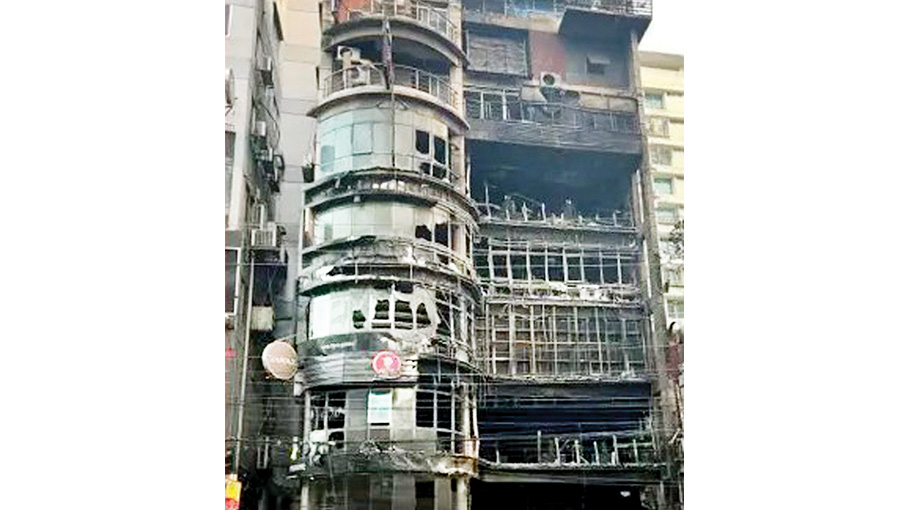Dhaka city highly blaze-prone

Most of the areas in the capital city of Dhaka are fire incident-prone due to population density, flammable building materials, narrow roads, inadequate water supply and diminishing water sources day by day.
Shahjahan Sikder, Officer-in-Charge of Media Cell of Fire Service and Civil Defense (FSCD) told the Bangladesh Post that many fires and explosions are caused from gas leak, gas cylinder explosions, electrical cables and air conditioners, cigarette butts, stoves and gas lines.
He also said that the number of actual incidents of fire under the accidents of the 506 fire service and civil defense stations across the country has not been updated till 2024, so it is not possible to tell the actual number of incidents.
However, according to the annual calculations of several years, a total of 27 thousand 624 fire incidents occurred across the country till 2023.
Among them, in September 2023, at least 217 shops of Dhaka's Mohammadpur Krishi Market were burnt down. In April 2023, 3,845 shops burned down in Bangabazar, Bangladesh's largest cloth marketplace, causing a total loss of around Tk 300 crore. After 11 days, the shopping complex of Dhaka New Super Market was burnt to ashes in a terrible fire.
In August 2022, six bodies were found after a fire that broke out in a nearby plastic factory in Debidwarghat area of Chawkbazar, Dhaka.
In June 2022, at least 51 people were killed in an explosion at a BM container depot in Chattogram's Sitakunda Upazila.
In June 2021, at least 52 people, including women and children, died in a fire in a food processing factory of Hashem Food Limited in Narayanganj.
In July 2019, six employees of a spinning mill in Gazipur were killed in a factory fire.
In March 2019, at least 291 shops in the Dhaka North City Corporation (DNCC) market in Gulshan 1 were completely burnt down. In the same month, 26 people were killed and 73 injured in a devastating fire at
FR Tower, a 22-storey building in Dhaka's Banani.
In February 2019, a massive explosion in Old Dhaka's Churihatta area killed 67 people instantly. Later four others died.
In July 2017, at least 13 people were killed and over 50 injured in a boiler explosion at a factory in Gazipur.
In September 2016, a fire at a food and cigarette packaging factory in Dhaka killed at least 34 people and injured dozens.
In January 2015, at least 13 people died in a plastic factory fire in Dhaka.
In May 2013, a fire broke out at a garment factory in Dhaka, killing at least seven people. In January 2013, eight workers, mostly women, died in a fire at Smart Export Garments in the capital's Mohammadpur.
In November 2012, a fire at the Tazreen Fashions factory in Dhaka killed at least 112 workers and injured more than 150 others.
In December 2010, a fire at Ha-Meem Group's sportswear factory killed 26 people and injured nearly 100.
In June 2010, at least 124 people died in a massive fire that broke out in a chemical warehouse in Nimtoli, Old Dhaka.
In February 2010, a fire at a sweater factory in Dhaka killed 21 workers and injured around 50 others.
In February 2006, a fire at a textile factory in the port city of Chattogram that killed 65 workers and injured dozens.
In April 2005, a garment factory building collapsed in Dhaka, killing at least 64 people and injuring around 100.
In January 2005, a fire at a garment factory outside Dhaka killed 22 people and injured more than 50.
Shahjahan Sikder said an average of more than 77 fires occur every day. The official also said that food shops in different parts of the country are also at risk of similar fire incidents. According to fire service statistics, most of the fires are caused by electrical short circuits, burning cigarettes, stoves and leaking gas pipelines. According to the statistics, the estimated damage in the fire is Tk 792,36,82,014, said the Station Officer of Fire Service and Civil Defense Media Cell.
According to the annual statistics of the Bangladesh Fire Service and Civil Defense (BFSCD) Directorate, 18.17%, 15.36% and 15.96% of fires occurred in the Greater Dhaka region in the last few years. An average of more than 78 fires occur every day across the country.
Fire service statistics show, of the total fire incidents, 9,813 incidents (35.52%) happened due to electrical short circuits, 4,906 (17.76%) from burning cigarettes, 4,117 (15.11%) from oven, 923 (3.34%) from playing with fire, 770 (2.79%) from gas pipeline leakage, 124 (0.45%) from explosion of gas cylinder and boiler explosion and 87 fire incidents occurred due to firecracker explosions.
It is noted that Section 7 of the Fire Prevention and Extinguishing Act, 2003 and the Fire Prevention and Extinguishing Rules, 2014 supplementing this Act with Rule 22, 2014 require the approval of the Director General for any structural design or safety requirements of multi-storied commercial buildings.
An occupancy certificate is issued to ensure building compliance with fire service and civil defense, which many building owners are not following properly. Fire service officials claim they can only issue warnings.
Officials suspect that many new constructed buildings have gas cylinders on different floors and stairways and many buildings do not have fire exits, which can lead to more serious accidents at any time.
Fire service officials also claimed that after the fire in Bangabazar hawker market last April, the market authorities had been warned more than 10 times in six years to implement fire safety measures, which are not being implemented in many cases.
Dhaka has a relatively high incidence of fire due to mixed business use with various hotels in commercial buildings. An average of more than 78 fires occur every day across the country. Human indifference is behind the fire. Fire service and civil defense said that it is not possible to reduce fire incidents if people are not aware.
Meanwhile, 32 people were admitted to the Sheikh Hasina National Institute of Burns and Plastic Surgery in Dhaka with more than 50 percent burns caused by a gas cylinder explosion earlier on Wednesday (March 13) evening before Iftar.
It is to be noted that in the house where the incident took place, someone from the family wrapped the hot defective leaking gas cylinder with a wet cloth and left it outside. Many garment workers were returning home from garment factories during Iftar. Along with them, the surrounding children also gathered to watch the event. No one understood that the gas coming out of the cylinder was spreading in the whole area. At that time, when the neighboring household person went to cook, the fire spread all over the street and more than 50 percent of 32 people were burnt in the gas cylinder explosion.




